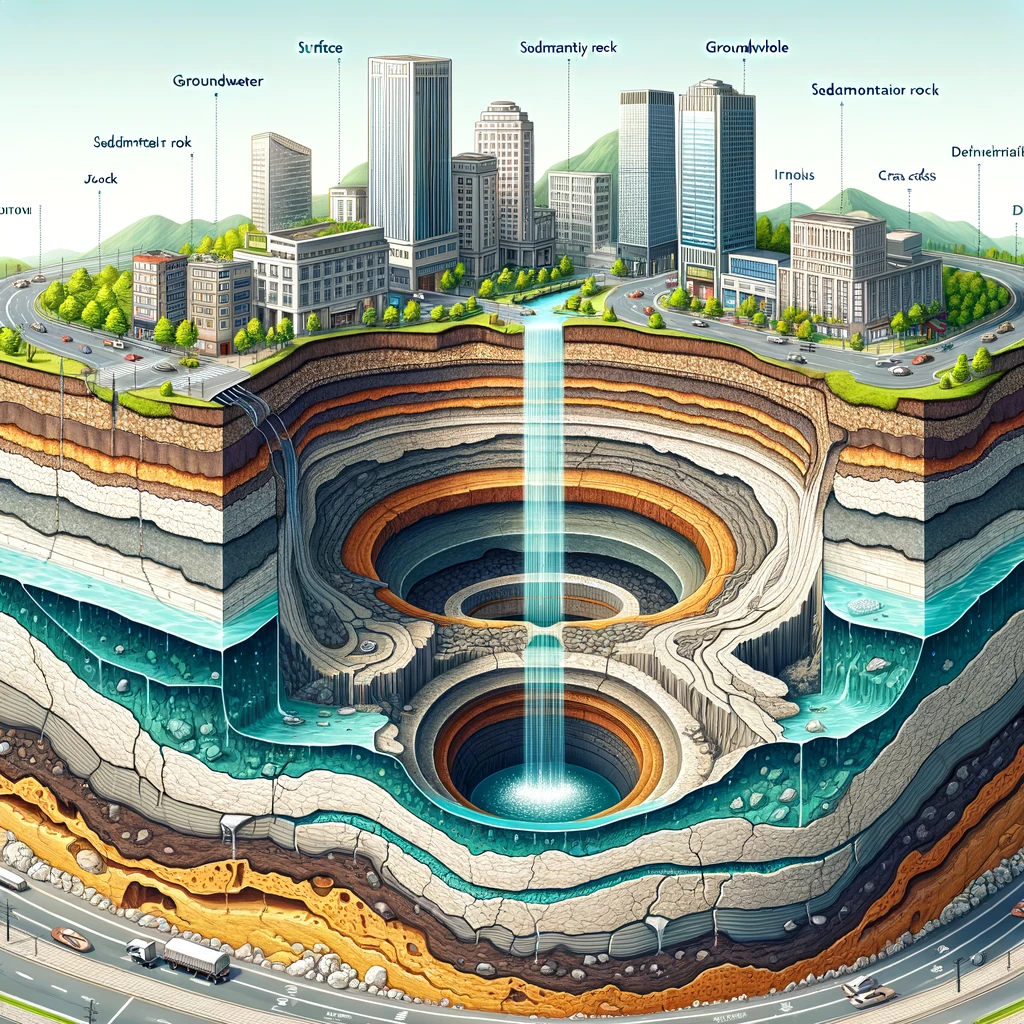In this blog post, we will discuss the causes of sinkholes and the safety of underground spaces from a geological and rock mechanics perspective, focusing on the sinkhole that occurred in Songpa-gu, Seoul, South Korea. Sinkholes are caused by both natural and anthropogenic sources, and their frequency and size vary depending on various geological factors.
One unfamiliar term that has been in the news a lot lately is “sinkhole”. A sinkhole is a phenomenon in which the ground collapses due to a change in the earth’s crust that weakens the support of the upper part. It’s easy to understand if you think of the old Korean expression “the ground gives out”. However, the word ‘sinkhole’ is not used much in everyday life, so it seems unfamiliar, and even those who know its meaning are rarely able to explain its cause. Therefore, in this article, I would like to identify the causes of sinkholes based on my knowledge of geology, and reveal the rock mechanics related to the destruction of underground space, using the case of Songpa-gu, Seoul, Korea, as an example.
First, let’s take a look at the causes of sinkholes. Sinkhole formation is largely influenced by groundwater in the earth’s crust. There are two main types of sinkholes: those caused by large flows of groundwater due to tectonic movements and those caused by human exploitation of groundwater. In other words, sinkholes can be divided into natural and anthropogenic causes. The former can be large, creating pits as high as 20 storeys, while the latter are relatively small. It’s a common misconception that only humans are responsible for sinkholes. Sinkholes caused by subway line construction, such as the one in Songpa-gu, Seoul, South Korea, are included in the anthropogenic category, and almost 100% of sinkholes in Korea are caused by humans. Now, I will explain the reasons from a geological perspective.

In order for water to be stored inside the earth’s crust, there must be a lot of empty space in the underground space. In this case, cracks are more likely to form in sedimentary rocks, which are relatively weak compared to metamorphic or igneous rocks. Therefore, the more the ground is composed of sedimentary rocks, the more vulnerable it is to sinkholes. However, fortunately, the ground in Korea is mostly composed of granite, a type of igneous rock, and gneiss, a type of metamorphic rock. Therefore, even if a sinkhole does occur, it does not collapse deeply and is relatively small in size. For example, the 20-storey sinkhole mentioned above occurred in Guatemala in North and Central America, where the bedrock is composed of sedimentary rock.
In summary, the sinkhole in Songpa-gu, Seoul, South Korea, collapsed because the hole in the ground created by construction could not withstand the forces from above, despite the solid granite bedrock. Now, let’s take a look at what factors determine the limits of the forces that a cavity, or hole, can withstand from a rock mechanics perspective. A cavity in the ground is subject to gravitational forces. How much force they can withstand depends on the type and condition of the rocks and the shape of the cavity.
First, the type of rock that makes up the Earth’s crust has an impact. The harder the bedrock, the more weight it can withstand. For example, concrete will be able to withstand much more weight than tofu. Second, the condition of the bedrock determines how much weight it can hold. There are many cracks in the bedrock that were created during tectonic movements, and they come in different sizes and shapes. These cracks can be filled with groundwater, which directly supports the hollow spaces in the bedrock, or they can be filled with water, which increases the viscosity of the bedrock, which increases its strength. This is easy to understand if you remember building toadstools as a child and finding that the ones made of waterlogged soil were stronger. Finally, the shape of the cavity is also important when it comes to artificially creating underground cavities for purposes such as subway construction. When a hole is shaped like a typical tunnel (a semicircular column), the amount of force it can withstand depends on the ratio of its width to its height: it is more stable when it is wider than it is tall, because the wider the area that accepts the force above the hole, the more the force is distributed. It’s the same reason why it’s easier to crack an egg by pressing it with the palm of your hand than it is to crack it upright.
In addition to the sinkhole in Songpa-gu, Seoul, South Korea, there is currently a lot of underground development under the city centre, and there is no telling when the same incident will happen again. What’s worse is that these sinkholes are disasters that the average person can’t normally prepare for, so experts are calling for regular ground surveys to be conducted and for underground spaces to be designed safely by considering various factors.
 I’m a blog writer. I want to write articles that touch people’s hearts. I love Coca-Cola, coffee, reading and traveling. I hope you find happiness through my writing.
I’m a blog writer. I want to write articles that touch people’s hearts. I love Coca-Cola, coffee, reading and traveling. I hope you find happiness through my writing.